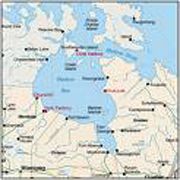 ADS-B has been in operation over a vast area of northern Canada for more than two months and air traffic services provider Nav Canada and the technology provider Sensis say it’s working as advertised. While the 250,000 square nautical miles covered by the system is scantily populated and encompasses Hudson Bay, its high-altitude airspace is used by 35,000 flights between Europe and North America every year. Until earlier this year, those flights simply dropped off controllers’ radar until they emerged hours later on the other side. With ADS-B, Nav Canada controllers can accurately track anything above 29,000 feet over the whole area and that means more efficient use of the routes. “With the accuracy of Sensis ADS-B, we can maximize airspace capacity by reducing separation standards from the current procedural separation of 80 miles to the five-mile separation standard now used in airspace with surveillance coverage,” said Nav Canada spokesman Rudy Kellar.
ADS-B has been in operation over a vast area of northern Canada for more than two months and air traffic services provider Nav Canada and the technology provider Sensis say it’s working as advertised. While the 250,000 square nautical miles covered by the system is scantily populated and encompasses Hudson Bay, its high-altitude airspace is used by 35,000 flights between Europe and North America every year. Until earlier this year, those flights simply dropped off controllers’ radar until they emerged hours later on the other side. With ADS-B, Nav Canada controllers can accurately track anything above 29,000 feet over the whole area and that means more efficient use of the routes. “With the accuracy of Sensis ADS-B, we can maximize airspace capacity by reducing separation standards from the current procedural separation of 80 miles to the five-mile separation standard now used in airspace with surveillance coverage,” said Nav Canada spokesman Rudy Kellar.
The five-mile separation allows the most direct routing for almost all flights and Nav Canada estimates that will save 4.5 million gallons of fuel and 50,000 tons of carbon emissions a year, once all aircraft using the airspace are equipped for ADS-B. Nav Canada is expanding ADS-B to areas Labrador and Baffin Island that don’t have radar coverage.


































